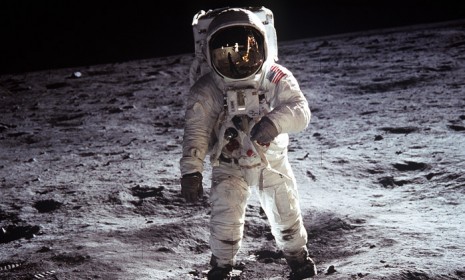Where did the water on the moon come from?
Icy droplets on the lunar surface are more prevalent than we ever thought, and now scientists think they know how the particles got there

Once upon a time the moon was thought to be dry, dusty, and barren. But over the years scientists have discovered more and more signs that the moon has deposits of icy water on its surface. And based on new analysis of soil samples collected some 43 years ago by Neil Armstrong and other Apollo astronauts, scientists have a better idea of how, exactly, the icy water droplets got there in the first place. Here, a guide to the findings:
How do we know there's water on the moon?
"Icy drops of water" are being found on the moon's surface with more and more frequency, says Nick Collins at Britain's The Telegraph. In 2009, a NASA satellite "slammed into a crater and threw up a plume which scientists found contained an unexpectedly high amount of ice." Subsequent probes revealed similar evidence of H2O. How it got there, however, has long been a mystery.
The Week
Escape your echo chamber. Get the facts behind the news, plus analysis from multiple perspectives.

Sign up for The Week's Free Newsletters
From our morning news briefing to a weekly Good News Newsletter, get the best of The Week delivered directly to your inbox.
From our morning news briefing to a weekly Good News Newsletter, get the best of The Week delivered directly to your inbox.
So… where did all that water come from?
When moon samples brought back by Apollo astronauts were first studied in the 1970s, scientists uncovered trace amounts of hydrogen hidden inside the volcanically produced moon dust. In a new paper, Yan Liu, a research professor at the University of Tennessee, makes the case that rather than being delivered to the moon by an icy comet or asteroid, water formed right there on the surface thanks to a phenomenon known as solar wind.
What's solar wind?
"Solar wind is a flow of particles continually flowing away from the sun," says The Telegraph's Collins. Earth's magnetic field typically deflects these particles away, but the moon doesn't have the same kind of protection. Solar wind "whacks into the lunar surface" at approximately a million miles per hour, often carrying hydrogen with it, says AFP. The impact is "so brutal" that the sun's gust diminishes the moon's mass by a million tons per hour. Although it's unclear exactly how the next step happens, the foreign hydrogen then combines with the moon's oxygen to form hydroxyls, or tiny glassy, bead-like compounds comprised of one oxygen atom and one hydrogen atom, says Irene Klotz at Discovery News. These hydroxyls, which Liu and his team discovered using new soil analysis techniques, get stored in the soil and are just one hydrogen atom away from becoming water.
A free daily email with the biggest news stories of the day – and the best features from TheWeek.com
What does this mean?
"So far, the only generally accepted way of delivering water to the inner solar system is collision with water-rich asteroid or comets that originated from the outer solar system," says geochemist Marc Chaussidon. What this means, says Liu, is that water "likely exists on Mercury and on other asteroids such as Vesta or Eros further within our solar system."
Sources: AFP, Discovery News, The Los Angeles Times, The Telegraph


